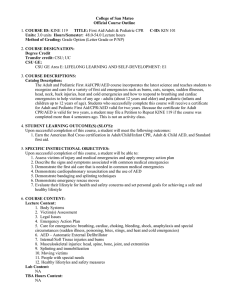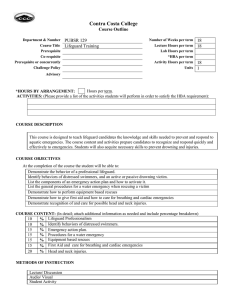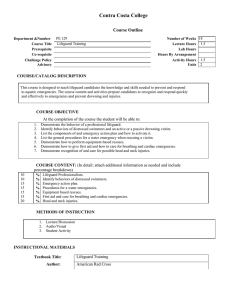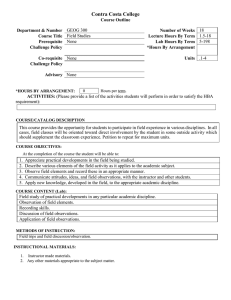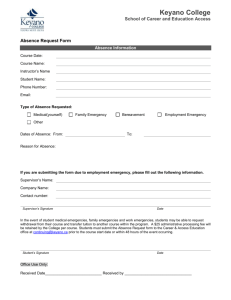HED 133-SP13.doc 79KB Feb 18 2014 10:43:39 AM
advertisement
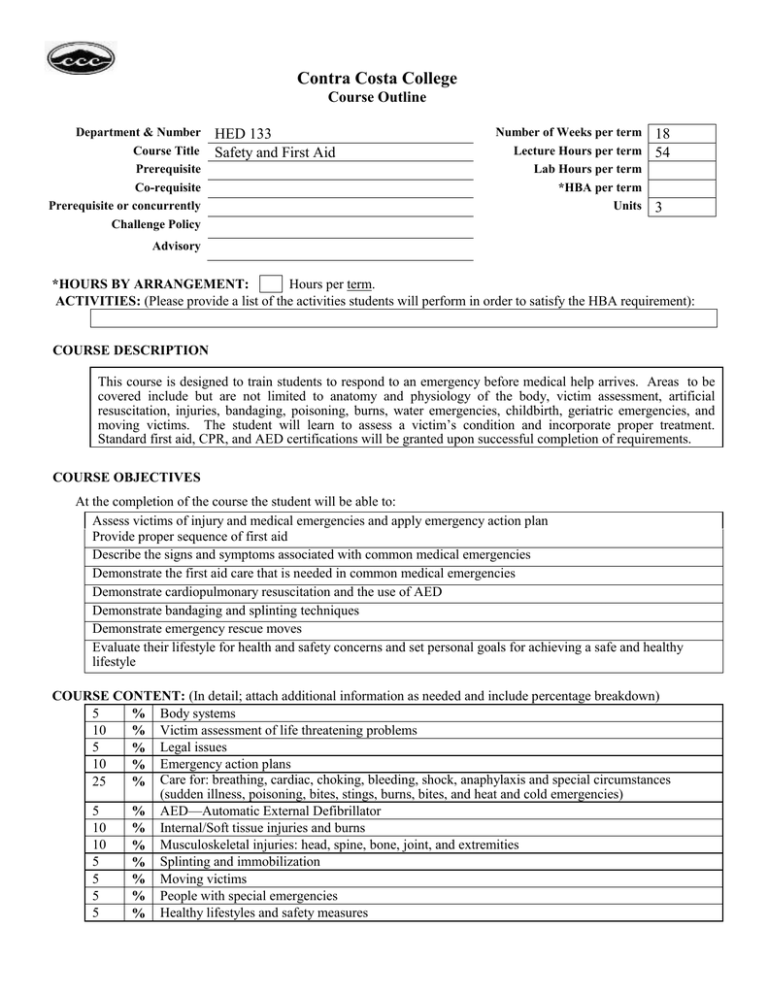
Contra Costa College Course Outline Department & Number Course Title Prerequisite Co-requisite Prerequisite or concurrently Challenge Policy HED 133 Safety and First Aid Number of Weeks per term Lecture Hours per term Lab Hours per term *HBA per term Units 18 54 3 Advisory Hours per term. *HOURS BY ARRANGEMENT: ACTIVITIES: (Please provide a list of the activities students will perform in order to satisfy the HBA requirement): COURSE DESCRIPTION This course is designed to train students to respond to an emergency before medical help arrives. Areas to be covered include but are not limited to anatomy and physiology of the body, victim assessment, artificial resuscitation, injuries, bandaging, poisoning, burns, water emergencies, childbirth, geriatric emergencies, and moving victims. The student will learn to assess a victim’s condition and incorporate proper treatment. Standard first aid, CPR, and AED certifications will be granted upon successful completion of requirements. COURSE OBJECTIVES At the completion of the course the student will be able to: Assess victims of injury and medical emergencies and apply emergency action plan Provide proper sequence of first aid Describe the signs and symptoms associated with common medical emergencies Demonstrate the first aid care that is needed in common medical emergencies Demonstrate cardiopulmonary resuscitation and the use of AED Demonstrate bandaging and splinting techniques Demonstrate emergency rescue moves Evaluate their lifestyle for health and safety concerns and set personal goals for achieving a safe and healthy lifestyle COURSE CONTENT: (In detail; attach additional information as needed and include percentage breakdown) 5 % Body systems 10 % Victim assessment of life threatening problems 5 % Legal issues 10 % Emergency action plans 25 % Care for: breathing, cardiac, choking, bleeding, shock, anaphylaxis and special circumstances (sudden illness, poisoning, bites, stings, burns, bites, and heat and cold emergencies) 5 % AED—Automatic External Defibrillator 10 % Internal/Soft tissue injuries and burns 10 % Musculoskeletal injuries: head, spine, bone, joint, and extremities 5 % Splinting and immobilization 5 % Moving victims 5 % People with special emergencies 5 % Healthy lifestyles and safety measures METHODS OF INSTRUCTION Lecture Multimedia Group discussion Demonstration INSTRUCTIONAL MATERIALS Textbook Title: Author: Publisher: Edition/Date: First Aid for Colleges and Universities Karren, Keith, Hafen, Brent, Limmer, Daniel, Mistovich, Joseph Pearson, Benjamin Cummings 12th ed, 2012 NOTE: To be UC transferable, the text must be dated within the last 5 years OR a statement of justification for a text beyond the last 5 years must be included. COURSE EXPECTATIONS (Use applicable expectations) Outside of Class Weekly Assignments Weekly Reading Assignments Weekly Writing Assignments Weekly Math Problems Lab or Software Application Assignments Other Performance Assignments Hours per week 2 1 3 STUDENT EVALUATION: (Show percentage breakdown for evaluation instruments) 40 40 10 10 % % % % Exams and quizzes Skill performance tests Written and practical tests Assignment to assess lifestyle for health and safety concerns GRADING POLICY (Choose LG, P/NP, or SC) x Letter Grade Pass / No Pass Student Choice 90% - 100% = A 80% - 89% = B 70% - 79% = C 60% - 69% = D Below 60% = F 70% and above = Pass Below 70% = No Pass 90% - 100% = A 80% - 89% = B 70% - 79% = C 60% - 69% = D Below 60% = F or 70% and above = Pass Below 70% = No Pass Prepared by: BethGoehring Date: SP13 Form Revised 01/13
